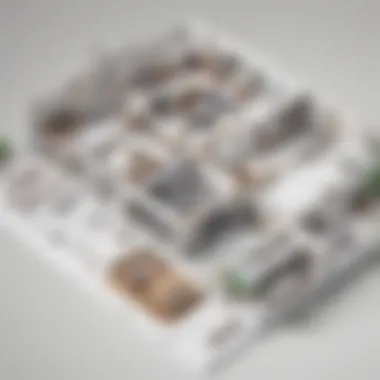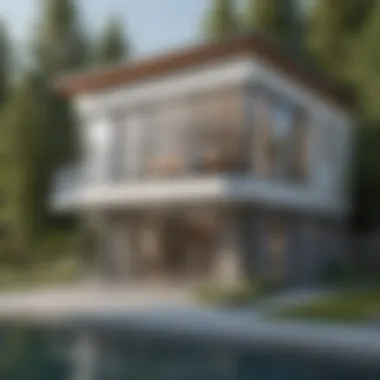Unleashing the Diverse Capabilities of SketchUp Design Software


Software Overview
SketchUp design software is a versatile tool tailored for small to medium-sized businesses, entrepreneurs, IT professionals, and decision-makers. By offering a comprehensive set of features and functionalities, SketchUp empowers users to create stunning visual representations and streamline design workflows effectively. When considering utilizing SketchUp, it's essential to explore the key features and functionalities it offers. These include intricate 3D modeling capabilities, intuitive design tools, seamless collaboration options, and a user-friendly interface. Additionally, understanding the pricing plans and available subscriptions can help decision-makers tailor their investment to suit their specific needs and budget constraints.
User Experience
The user experience with SketchUp is centered around its user interface and navigational elements. Navigating through the software is intuitive and user-friendly, allowing users to access various features with ease. The learning curve of SketchUp is notably favorable, making it a viable option for both beginners and experienced users looking to enhance their design skills. In terms of customer support, SketchUp offers reliable options to address any queries or issues users may encounter, ensuring a seamless experience throughout their design projects.
Performance and Reliability
One of the prominent features of SketchUp is its speed and efficiency, allowing users to render complex 3D models quickly and seamlessly. The software boasts impressive uptime statistics, minimizing disruptions during crucial design processes. Furthermore, integration capabilities with other tools enable users to enhance their productivity and workflow by seamlessly integrating SketchUp into their existing design arsenal, promoting a synergistic approach to design projects.
Security and Compliance
For businesses and professionals prioritizing data security, SketchUp incorporates robust data encryption and security protocols to safeguard user information and intellectual property. Moreover, SketchUp complies with industry regulations, providing users with assurance regarding data privacy and regulatory requirements. In terms of disaster recovery measures, SketchUp offers reliable backup options to protect against data loss, ensuring continuity in design projects.
Introduction to SketchUp
SketchUp design software is a versatile tool that holds immense importance in the realm of design and visualization. This section serves as a foundational guide, outlining key elements and benefits integral to understanding SketchUp's interface. As we delve deeper into SketchUp's capabilities, users gain access to a world of possibilities for creating visually stunning projects. From small to medium-sized businesses, entrepreneurs, IT professionals, to decision-makers, grasping the fundamentals of SketchUp sets the stage for enhanced design workflows and elevated project outcomes.
Understanding SketchUp Interface
Exploring the Toolbar
Exploring the Toolbar in SketchUp plays a crucial role in facilitating efficient design processes. Its intuitive layout enables users to access a wide range of tools required for precise modeling and rendering. One key characteristic of the Toolbar is its customizable nature, allowing users to personalize their workspace for optimal productivity. This feature makes the Toolbar a popular choice among designers looking to streamline their workflow. However, the abundance of tools within the Toolbar can be overwhelming for beginners, necessitating a learning curve to fully harness its potential.
Navigation Tools Overview
The Navigation Tools in SketchUp provide users with essential functionalities for moving around the 3D space seamlessly. By understanding the key characteristic of each navigation tool, designers can navigate their models with precision and ease. These tools offer a beneficial choice for this article as they enhance user experience by simplifying model exploration and manipulation. However, mastering the Navigation Tools requires practice, as each tool serves a specific purpose that contributes to the overall efficiency of the design process.
Categorizing Components
Categorizing Components within SketchUp allows designers to organize their project elements systematically. This feature's key characteristic lies in its ability to classify objects based on their attributes, making project management more structured and manageable. The unique feature of Categorizing Components is its time-saving functionality, as users can easily locate and edit specific elements within complex projects. While this feature offers significant advantages in terms of project organization, over-categorization may lead to complexity and hinder workflow optimization.
Key Features of SketchUp
3D Modeling Capabilities
SketchUp's 3D modeling capabilities stand out as a cornerstone feature for designers aiming to bring their ideas to life in a three-dimensional space. The key characteristic of these capabilities lies in their user-friendly interface, allowing both beginners and seasoned professionals to engage in 3D modeling with ease. One unique feature of SketchUp's 3D modeling is its push-pull tool, enabling quick manipulation of shapes and forms, enhancing the design process's efficiency. Despite its advantages, mastering advanced 3D modeling techniques may require additional training to leverage the full potential of this feature.


Texture Mapping Techniques
Texture mapping techniques in SketchUp offer designers the ability to add realism and depth to their models through the application of textures. The key characteristic of these techniques lies in their contribution to creating immersive visual experiences within virtual environments. One unique feature is SketchUp's seamless integration with various texture libraries, providing users with a vast array of material options to enhance their designs. However, understanding the nuances of texture mapping is essential to avoid visual clutter and maintain a cohesive design aesthetic.
Dimensioning and Labeling Functions
Dimensioning and labeling functions in SketchUp aid in communicating spatial relationships and design parameters effectively. The key characteristic of these functions is their precision and accuracy in annotating models with measurements and descriptions. A unique feature of SketchUp's dimensioning and labeling tools is their dynamic nature, allowing adjustments to be made in real-time without compromising design integrity. While these functions streamline the documentation process, meticulous attention to detail is necessary to ensure clear and concise annotations.
SketchUp Versions and Licensing Options
SketchUp Free vs. SketchUp Pro
The comparison between SketchUp Free and SketchUp Pro provides users with insight into the features and limitations of each version. The key characteristic of SketchUp Free is its accessibility, allowing users to experience basic functionalities without financial commitment. In contrast, SketchUp Pro offers advanced tools and capabilities tailored for professional designers seeking comprehensive design solutions. A unique feature of SketchUp Pro is its compatibility with third-party plugins, expanding its functionality beyond the standard features available in SketchUp Free. Understanding the nuances of each version is crucial in determining the most suitable option based on individual design needs.
Subscription Models Comparison
Comparing SketchUp's subscription models aids users in selecting the payment plan that aligns with their budget and design requirements. The key characteristic of subscription models is their flexibility, offering users the option to access SketchUp's full capabilities without a significant upfront cost. A unique feature of SketchUp's subscription models is the regular updates and support services provided to subscribers, ensuring they have access to the latest features and improvements. However, subscription-based licensing may pose challenges for users with limited budgets or those preferring a one-time purchase model. Choosing the right subscription plan entails a careful evaluation of long-term design goals and financial considerations.
Enterprise Solutions Overview
An overview of SketchUp's enterprise solutions sheds light on the options available for larger organizations with complex design needs. The key characteristic of enterprise solutions is their scalability, catering to multi-user environments and collaborative design workflows. A unique feature of SketchUp's enterprise solutions is the centralized project management dashboard, enhancing communication and version control within large design teams. While enterprise solutions offer comprehensive features tailored for organizational requirements, implementing such solutions may require dedicated IT support and training to maximize efficiency and utilization.
Utilizing SketchUp for Design Projects
Utilizing SketchUp for Design Projects is a pivotal aspect of this article, showcasing the software's applications and benefits for small to medium-sized businesses, entrepreneurs, IT professionals, and decision-makers. By harnessing SketchUp's versatile capabilities, users can streamline their design processes and create visually stunning representations. From architectural designs to interior layouts and landscape modeling, SketchUp offers a comprehensive platform to bring creative visions to life. The intuitive interface and powerful features of SketchUp make it a go-to tool for professionals looking to enhance their design workflows.
Architectural Design Applications
Creating Floor Plans
Creating Floor Plans in SketchUp is a crucial function that allows designers to lay out the foundation of their architectural projects with precision and clarity. The key characteristic of Creating Floor Plans in SketchUp is its user-friendly interface, which enables users to draft layouts efficiently. This feature is a popular choice for architecture professionals due to its ability to visualize spatial arrangements effectively. The unique feature of Creating Floor Plans lies in its customization options, offering flexibility in design while ensuring accuracy in measurements. These plans contribute significantly to architectural projects by serving as the blueprint for construction, guiding the entire building process.
Simulating Construction Elements
Simulating Construction Elements in SketchUp adds a practical edge to design projects by allowing users to test the feasibility of their structural ideas. The key characteristic of this feature is its ability to simulate real-world construction processes within the software environment. It is a beneficial choice for designers as it helps identify potential challenges and refine construction strategies before implementation. The unique feature of Simulating Construction Elements is the integration of different materials and structural components, providing a comprehensive overview of the project's buildability. However, the complexity of detailed simulations can sometimes impact software performance, requiring efficient handling for optimal results.
Rendering Realistic Architectural Models
Rendering Realistic Architectural Models in SketchUp elevates design presentations to a professional level by imbuing them with lifelike visualizations. The key characteristic of this feature is its ability to create photorealistic textures and lighting effects, enhancing the overall aesthetics of architectural models. It is a popular choice for design professionals seeking to showcase their projects with cinematic quality. The unique feature of Rendering Realistic Architectural Models lies in its animation capabilities, allowing for dynamic walkthroughs and immersive experiences for viewers. While this feature enhances design quality, intricate rendering processes may extend project timelines, requiring careful management during project development.


Interior Design Functionality
Customizing Furnishing Layouts
Customizing Furnishing Layouts in SketchUp enables designers to tailor interior spaces according to specific design preferences and functional requirements. The key characteristic of this feature is its vast library of furniture and decor components, offering versatility in design exploration. It is a beneficial choice for interior designers looking to create personalized room layouts with ease. The unique feature of Customizing Furnishing Layouts is the ability to accurately scale and position furnishings within the virtual space, providing a realistic representation of the final design. However, extensive customization options may lead to design clutter if not managed efficiently, necessitating a balance between creativity and functionality in layout design.
Color Schemes Visualization
Color Schemes Visualization in SketchUp empowers designers to experiment with different color palettes and finishes to visualize the ambiance of interior spaces accurately. The key characteristic of this feature is its color picker tool, which enables users to select and apply colors seamlessly to various surfaces. It is a popular choice for design professionals seeking to evoke specific moods or styles within their design concepts. The unique feature of Color Schemes Visualization lies in its coordination with lighting effects, enhancing color accuracy under different lighting conditions for realistic visualizations. While color visualization aids in design decision-making, excessive color choices may overwhelm the design process, necessitating a thoughtful approach to color harmonization.
Lighting Effects Implementation
Lighting Effects Implementation in SketchUp plays a crucial role in enhancing the atmosphere and functionality of interior spaces through strategic lighting design. The key characteristic of this feature is its dynamic lighting controls, allowing designers to adjust light intensity and direction to achieve desired effects. It is a beneficial choice for design professionals aiming to create immersive lighting scenarios within their projects. The unique feature of Lighting Effects Implementation is the capability to simulate natural and artificial lighting sources realistically, enabling designers to assess lighting impact accurately. However, intricate lighting setups may demand additional computational resources and optimization techniques to maintain software performance during rendering processes.
Landscape Design Possibilities
Terrain Modeling Techniques
Terrain Modeling Techniques in SketchUp facilitate the creation of intricate landscapes with varying elevations and topographic features. The key characteristic of this feature is its terrain sculpting tools, which enable users to mold virtual terrains with precision. It is a popular choice for landscape designers seeking to replicate real-world landforms in their projects. The unique feature of Terrain Modeling Techniques lies in its integration with Geographic Information System (GIS) data, allowing for accurate terrain mapping and analysis. While terrain modeling enhances landscaping realism, complex terrain modifications may require advanced knowledge of landscape design principles for optimal results.
Plant and Vegetation Design
Plant and Vegetation Design in SketchUp empowers designers to populate their landscapes with diverse plant species and greenery to enhance visual appeal and environmental significance. The key characteristic of this feature is its extensive plant library, offering a wide selection of flora for realistic landscaping designs. It is a beneficial choice for landscape architects aiming to create biologically diverse and aesthetically pleasing outdoor environments. The unique feature of Plant and Vegetation Design is the plant distribution tool, enabling users to place vegetation realistically according to environmental conditions. However, the abundance of plant choices can overwhelm design compositions if not balanced effectively, requiring a keen understanding of botanical arrangement principles for cohesive landscape designs.
Water Features Integration
Water Features Integration in SketchUp introduces dynamic elements such as ponds, rivers, and waterfalls into landscape designs, enhancing the natural character and sensory experience of outdoor spaces. The key characteristic of this feature is its water simulation tools, enabling users to create realistic water bodies with moving water effects. It is a beneficial choice for landscape designers looking to add interactive elements and visual interest to their projects. The unique feature of Water Features Integration lies in its water manipulation controls, allowing for precise adjustments in water flow and appearance. While water features enrich landscape aesthetics, complex water simulations may impact software performance, necessitating efficient optimization for seamless design integration.
Enhancing Workflow Efficiency with SketchUp
In this pivotal section of the article, the focus shifts towards enhancing workflow efficiency with the revolutionary SketchUp software. Small to medium-sized businesses, entrepreneurs, and IT professionals can greatly benefit from maximizing productivity and streamlining design processes through the adept utilization of SketchUp. Improving workflow efficiency is not merely a preference but a necessity in today's fast-paced industry landscape. SketchUp offers a myriad of tools and features that enable seamless collaboration, precise version control, and efficient feedback integration, culminating in a cohesive and dynamic workflow environment.
Collaborative Design Tools
Shared Project Access:
Shared project access within SketchUp encapsulates the essence of collaborative design efforts. This feature allows multiple users to work on the same project simultaneously, fostering real-time contributions and feedback exchange. The shared access functionality promotes synergy among team members, eliminates version disparities, and enhances project coherence. Its real-time updating feature ensures that all stakeholders are constantly in the loop, resulting in accelerated decision-making processes and optimal project outcomes.
Version Control Mechanisms:


The version control mechanisms integrated within SketchUp offer meticulous oversight and management of project iterations. This feature enables users to track changes, revert to previous versions if necessary, and maintain project integrity throughout the design process. Version control ensures that all modifications are documented, providing a transparent audit trail for enhanced project accountability and control. Moreover, it prevents inadvertent data loss or design discrepancies, contributing significantly to the overall workflow consistency and quality.
Feedback Integration Features:
Feedback integration features in SketchUp play a pivotal role in refining design iterations and incorporating stakeholder insights seamlessly. This functionality allows for centralized feedback collection, annotation, and resolution within the software interface. By facilitating direct communication channels for feedback interpretation and implementation, SketchUp empowers users to address design nuances promptly, resulting in iterative improvements and design precision. The feedback integration features enhance communication efficiency, minimize errors, and promote collaborative decision-making, ultimately enhancing the overall design workflow productivity.
Integration with Other Software
In the realm of design integration, SketchUp stands out for its seamless compatibility with rendering programs, extensive exporting and importing options, and versatile workflow automation plugins. The interoperability of SketchUp with various software applications amplifies its utility and versatility for design professionals. By exploring the nuanced aspects of compatibility with rendering programs, users can leverage advanced visualization capabilities to enhance design presentations and realism. Additionally, comprehensive exporting and importing options facilitate smooth data exchange between SketchUp and external platforms, optimizing workflow connectivity and data transfer efficiency.
Work
flow automation plugins further augment efficiency by automating repetitive tasks, optimizing design processes, and customizing workflows to individual preferences. By incorporating these plugins, users can streamline tedious operations, reduce manual intervention, and enhance productivity manifold. The integration with other software applications broadens SketchUp's functionality spectrum, empowering users to leverage diverse design resources, extend capabilities, and synchronize workflows seamlessly.
Tips and Tricks for Optimal SketchUp Usage
Delving into the finer nuances of SketchUp usage, tips, and tricks can significantly elevate design proficiency and maximize software utilization. From mastering keyboard shortcuts for efficiency to implementing advanced 3D modeling techniques and effectively troubleshooting common issues, optimizing SketchUp usage entails a comprehensive understanding of its toolset.
Keyboard Shortcuts for Efficiency:
The adept use of keyboard shortcuts is a hallmark of proficient SketchUp users aiming to expedite design tasks and streamline operations. By strategically deploying keyboard shortcuts for common commands, users can navigate the software interface swiftly, execute functions efficiently, and enhance overall productivity. Learning and customizing keyboard shortcuts tailored to individual workflow requirements can significantly reduce design time, minimize manual input, and foster a fluid design process.
Advanced 3D Modeling Techniques:
Mastering advanced 3D modeling techniques within SketchUp empowers designers to transcend conventional design boundaries, explore intricate geometries, and manifest complex design visions with precision. These techniques encompass parametric modeling, organic form creation, material manipulation, and intricate detailing, enabling users to push the boundaries of design innovation. By honing advanced 3D modeling skills, designers can realize intricate design concepts, optimize spatial dynamics, and imbue projects with unparalleled sophistication and finesse.
Troubleshooting Common Issues:
Efficiently troubleshooting common issues in SketchUp is crucial for maintaining workflow continuity and resolving design impediments effectively. By familiarizing themselves with prevalent software glitches, performance bottlenecks, and error resolution strategies, users can mitigate setbacks, optimize software performance, and sustain design momentum. Troubleshooting common issues involves diagnostic analysis, systematic problem-solving approaches, and proactive error prevention strategies, ensuring seamless design execution and consistent software functionality.
Conclusion: Embracing the Potential of SketchUp
In the winding journey through the multifaceted realm of SketchUp, the culminating endeavor of embracing its potential emerges as a pivotal milestone. This crucial section unveils the future vistas for design enthusiasts and professionals. By deciphering and comprehending the advanced functionality and possibilities encapsulated within SketchUp, individuals and businesses can catapult their design endeavors to unprecedented heights. The seamless integration of SketchUp's tools and features provides a gateway to unparalleled innovation and creativity in the design sphere. Embracing SketchUp signifies embracing efficiency, precision, and boundless creativity, acting as a cornerstone for shaping visionary outcomes in various design projects.
Future Trends and Developments
Virtual Reality Integration
Within the intriguing landscape of design technology, Virtual Reality (VR) Integration emerges as a transformative force propelling SketchUp into a new era. The essence of VR Integration lies in its immersive capabilities, offering users an unparalleled experience that blurs the lines between reality and virtuality. By simulating real-world environments and interactions, VR Integration revolutionizes the design process, enabling stakeholders to visualize and experience designs in a way previously unattainable. The unique feature of VR Integration lies in its ability to enhance spatial perception and user engagement, fostering a deeper understanding of design concepts and spatial relationships. While VR Integration introduces a new dimension of visual communication and experiential design, its implementation in SketchUp opens a portal to expansive creative possibilities, redefining standards of design visualization.
AI-Assisted Design Enhancements
Amid the dynamic landscape of design evolution, AI-Assisted Design Enhancements stand as pillars of ingenuity and efficiency within the SketchUp milieu. The inherent brilliance of AI lies in its capacity to streamline design processes through intelligent automation and predictive analysis. By leveraging AI algorithms and machine learning capabilities, SketchUp transcends conventional design boundaries, offering users advanced tools for complex problem-solving and ideation. The unique feature of AI-Assisted Design lies in its ability to adapt to user preferences and optimize design workflows, facilitating seamless collaboration and ideation. While AI-Assisted Design enhances productivity and precision, it also raises contemplation on ethical considerations and human-machine interaction, shaping the future narrative of design innovation.
Cloud-Based Collaboration Advancements
Envisioning the collaborative landscape of design software, Cloud-Based Collaboration Advancements emerge as beacons of connectivity and accessibility within SketchUp's ecosystem. Facilitating real-time interaction and data sharing, Cloud-based platforms revolutionize team collaboration, breaking barriers of geographical constraints and time zones. The key characteristic of Cloud-Based Collaboration lies in its capacity to centralize project assets and foster streamlined communication, reducing inefficiencies and enhancing productivity. The seamless integration of cloud technology within SketchUp expands the horizons of collaborative design, empowering users to co-create and visualize designs in a synchronized virtual environment. While Cloud-Based Collaboration amplifies connectivity and flexibility, its reliance on internet connectivity and data security poses contingencies that necessitate strategic considerations and risk mitigation strategies within design workflows.







